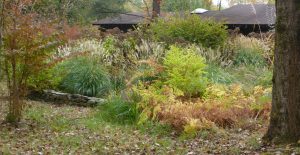Another gardening season has come to a close, but there are still a few things left to do before it’s time to hang up your trugs and trowels till spring. And while it may be tempting to just call it quits, getting around to some of these tasks now will make your gardening life easier in the spring –when your list of garden to-do’s will be even longer than it is at this time of year. So grab a sweatshirt, pull on your warm hat – -and get on out there!
Check out our checklist for what needs to be done now to help your garden weather the winter ahead:
 Construct a compost bin or pile
Construct a compost bin or pile
Things are piling up –in a good way! A compost bin not only makes fall cleanup easier by corralling yard debris, it offers a big garden payoff once these materials break down. A win-win! Recycling fallen leaves and other garden waste into compost yields “garden gold” aka, compost: a rich dark, soil amendment that improves soil and helps plants grow. If you don’t already have one, fall is a great time to start a compost pile. For how-tos, see: Composting at Home.
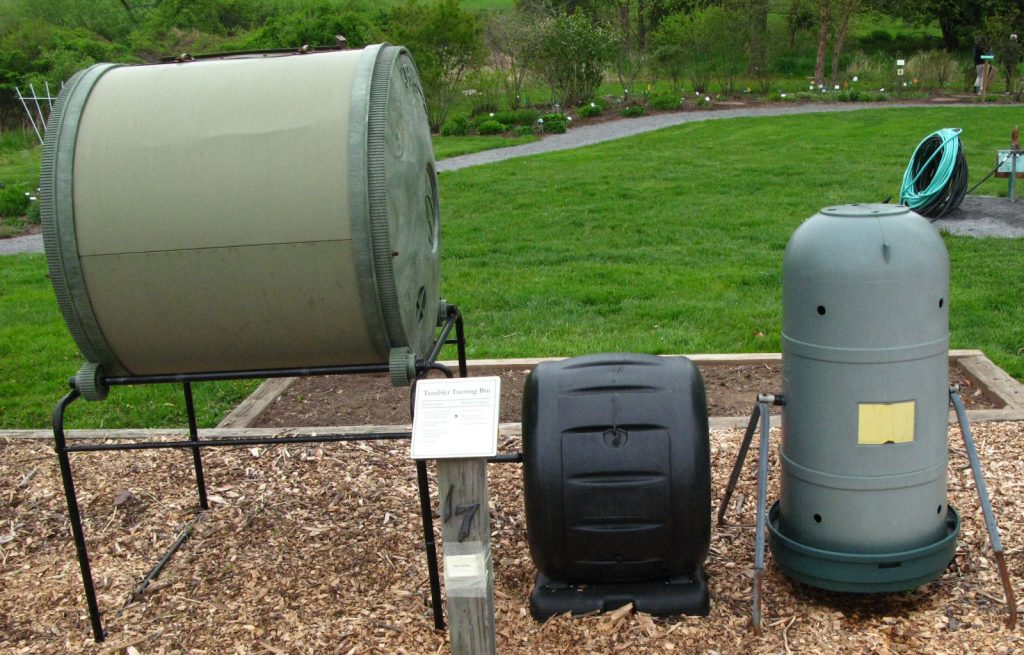
Not sure which type of composter is right for you? More than 20 different composting methods are on display at Mercer Educational Gardens. Each bin is maintained by a Master Gardener team and displays advantages and disadvantages right next to it. The site is open dawn to dusk, and offers self-guided tours so would-be compost creators can determine which type best suits their needs. Photo by Joe Scarlata.
 Compost backyard leaves.
Compost backyard leaves.
Leave the leaves on the lawn: Why not skip the rake altogether this year and instead, use the mulching blade on your lawnmower to grind up a thin (up to 4”) layer of leaves and leave them on the lawn? If the layer of leaves is too thick, you can remove most of them from the grass and compost them separately. (They will decompose more quickly if you put them through a shredder or run them over with a lawn mower first.) Oak leaves or other non-packing leaves can be used as mulch around roses and other shrubs. For more, see: Using Leaf Compost, or download Backyard Leaf Composting.
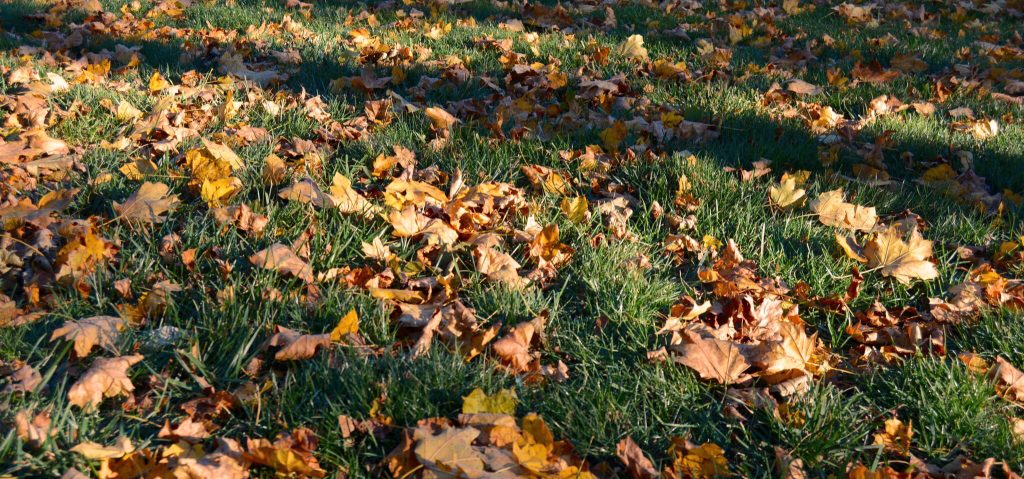
Skip the rake and leave the leaves! Mowing over fallen leaves with a mulching mower or a mulching attachment, chops leaves into smaller pieces that break down easier. Photo by Catherine Horgan
Destroy any plants in poor condition.
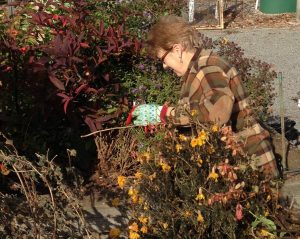
When cutting back plants in the fall, avoid adding plants with known diseases or pest problems to the compost pile. Photo by Margaret Montplaisir
Banish the blight: Get rid of any plants that are are diseased, insect-infested, or in otherwise poor condition. Prune back any perennials prone to disease, and pull out any weeds you find so weed seeds don’t get a chance to germinate and take over any open ground in spring. Chop up any healthy garden residue and add it to the compost pile.
Just remember to destroy, and not compost, any diseased or infested plant material.
 Leave some spent plant material for wildlife.
Leave some spent plant material for wildlife.
Welcome winter visitors: Support a wholesome ecosystem by not doing too good of a job “cleaning” this fall. Leave healthy stems and grasses in place for wildlife. Perennial stalks and ornamental grasses not only add interest to the winter landscape but also serve as hiding places for insect-eating toads and loads of over-wintering beneficial insects.
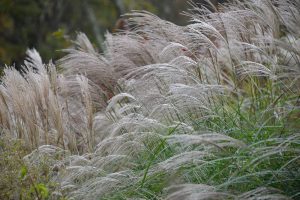
Leaving some grasses and stems not only provides winter interest, but can also serve as additional winter mulch, and help trap blowing snow and leaves. Photo by Eunice Wilkinson
And don’t forget the birds! Birds love to feast on the seeds of certain common flowers like coneflowers and black-eyed Susan. So why not leave them a wintertime treat and give yourself something to look at in the garden during the winter months?
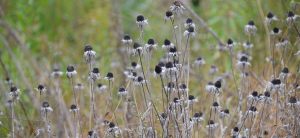
Overwintering birds rely on the seedheads of dried perennials, like these black-eyed Susans. Photo by Eunice Wilkinson.
While you’re at it, consider hanging up a bird house or two, and setting out some feeders to provide food and shelter for overwintering flocks.
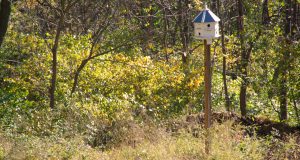
Residents of this bird house will be sitting pretty this winter, snugly surrounded by plenty of native trees, plants and grasses. Photo by Eunice Wilkinson
Keeping a heated birdbath or other water source filled and thawed will be a boon to birds when other water sources are frozen solid.
 Store tender bulbs, plants, and seeds.
Store tender bulbs, plants, and seeds.
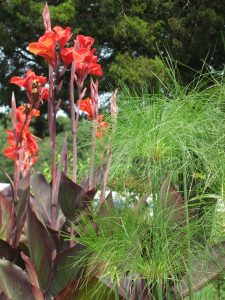
In the fall, dig up canna rhizomes, cut the stems back to 2-3 inches, and let them dry. Leave them in a box in a cool part of the house where they will not freeze, such as a basement where the temperatures range between 40-50 degrees.
Annual retreat: Hold on to a little bit of summer by bringing less-than-hardy plants inside. Store summer-blooming bulbs like dahlia, gladiolus, and canna (see also: Cannas ) in ventilated plastic bags in a cool, above-freezing spot.
You can also pot up your geraniums, wax begonias, lantana, rosemary, and other warm weather bloomers and grow them indoors. (See Keeping Geraniums Over Winter.)
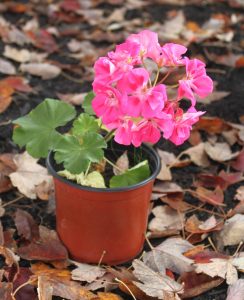
Many summer bloomers like geraniums can be potted up in the fall, overwintered indoors and then replanted in the spring. Photo by Margaret Montplaisir.
Tender annual flower seeds from this year’s garden can be collected, stored, and used next year. (For more info, download: Grow Your Own Vegetable and Flower Seedlings.)
Don’t bother saving seeds from hybrid varieties of annuals, perennials or vegetables though. Hybrid plants grown from seed might not have the characteristics of the original plant.
 Mow lawns until growth stops.
Mow lawns until growth stops.
Before the lawn starts to yawn: Keep on mowing until around Thanksgiving. This final mowing can be 2” to 2 ½” high. Don’t remove the clippings unless the mower is also used to pick up fallen leaves.
Give the lawn its final fertilization in November or early December and eliminate the need for spring fertilizing until May. This also helps reduce the incidence of lawn diseases that are influenced by heavy nitrogen applications in early spring. Many fall turf fertilizers contain a higher level of potassium, which is important for winter hardiness and disease resistance.
 Pull away any mulch around trunks of trees and shrubs.
Pull away any mulch around trunks of trees and shrubs.
Stop the (mulch) madness: Mulch that touches the trunks of trees invites fungus and insect problems, causes abnormal root growth, and may harbor “varmints,” such as voles, which eat tender bark and roots in winter. Maintain a “doughnut of mulch” around trees by keeping at least 4 inches between the mulch and the trunk. For more info, see: Problems with Over-Mulching Trees and Shrubs and Mulch for the Home Grounds.
Planning on buying a potted or balled and burlapped Christmas tree and planting it outdoors after the holidays? Be sure to dig the hole before the ground freezes. Place the soil in a box and store it where it won’t freeze. Then cover the hole with a plywood sheet or fill the hole with leaves or mulch until after the holidays when you’re ready to plant it.
 Protect small or marginally hardy plants
Protect small or marginally hardy plants
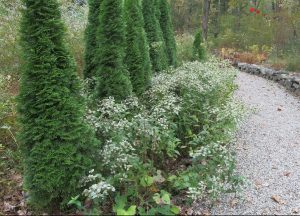
Winter injury can occur on a broad range of evergreen and deciduous plants like these arborvitae. To prevent breakage, wrap them with soft twine, pantyhose, or broad tape. Photo by Betty Scarlata.
Support your local trees and shrubs: Protect any plants or broadleaved evergreens that might be prone to winter burn. Try using a burlap screen supported by stakes to surround and protect them. Just be sure to put the stakes in the ground before the ground freezes in November. The burlap can be tacked to the stakes when the weather takes its inevitable turn in late December.
Multi-trunked or multi-stemmed evergreens, such as tall juniper, arborvitae, boxwood, and yews may split under the weight of wet snow or ice. Lend them some support by wrapping soft twine, pantyhose, or broad tape around them. Board shelters (a-frame structures like the sandwich boards used to advertise local delis) can be used to cover shrubs that are prone to snow damage–especially plants sited under the eaves of the house where they can get clobbered by snow sliding off the roof.
 Test garden soil
Test garden soil
Time to get testy: Fall is a great time to have soil tests run. (Just be sure to collect soil samples before the ground gets too hard to dig.) Test results will arm you with important information like the proper pH and nutrient levels for lawns and gardens and since the recommendations are customized to your yard, will spell out exactly how to amend your soil for a better garden next year. Word to the wise: If test results indicate that your lawn needs lime, do not apply when the ground is frozen or snow covered. (See: Soil Testing for more information.)
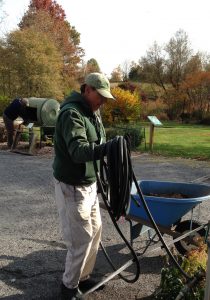
Properly storing tools and equipment, like garden hoses, will make them easier to work with next year and last longer.
 Clean and store garden tools
Clean and store garden tools
Tool time: Clean, oil and repair garden tools and store them indoors. Drain the gas tank of the lawn mower and other gas-powered equipment after the last use or run the mower until it runs out of gas. Drain and store garden hoses and watering equipment. Turn on older outdoor faucets, then turn off the water from the inside line to prevent pipes from freezing. (Some hose bibs turn off inside the house, so water drains out and pipes are not in danger of freezing.)
 Start planning for next year
Start planning for next year
Sweet dreams for a long winter’s nap: Once you’ve put your garden to bed, it’s time to cozy up inside and…start thinking about next year! When winter winds are howling outside, gardeners can nurture budding garden dreams by digging into some wonderful garden books and lingering over plant and seed catalogs, (a place to start: Mail Order Vegetable Seed Sources for the New Jersey Gardener)
Looking to up your garden game? Check out some gardening seminars and workshops over the winter and expand your gardening know-how for the season to come. 
Winter reading can provide just the inspiration you need to get through the frosty days ahead. Need a recommendation? Call the Master Gardener Helpline or join us for our annual garden Symposium in March where you can peruse the book sale for our garden must-reads. Photo by David Byers.There are lots of other horticultural events and workshops throughout the winter that can fill you with inspiration and help you get through those long gray months when spring seems so far away. Browse our Upcoming Events section for a look at what’s next.
Ready to take your gardening skills to the next level?
Why not become a Master Gardener and share your love of gardening with your whole community?
Find out how here: Become a Master Gardener
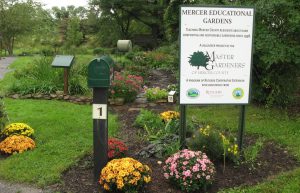
Join us! Master Gardeners volunteer their time, talent and passion for gardening to make the world a greener place. Among our labors of love is maintenance of Mercer County Educational Gardens, (above) a living affirmation of the beauty of responsible gardening. Photo by Joe Scarlata.
References:
Preparing the Garden for Winter
